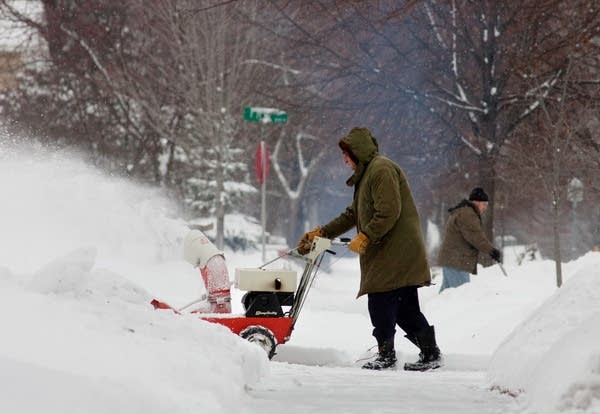Minnesota braces for more snow
Go Deeper.
Create an account or log in to save stories.
Like this?
Thanks for liking this story! We have added it to a list of your favorite stories.

The winter storm bearing down on Minnesota and much of the Midwest has delivered what it promised: treacherous travel conditions and an extra white Christmas.
Forecasters still expect 16 inches to 22 inches to fall through the holiday weekend in much of the state, along with some ice and blizzard conditions. Snow piled up on roads and runways as plows raced to keep up, but many travelers either beat the storm or decided to stay put, minimizing the storm's impact on public safety officials.
"We're still seeing a number of vehicles spin off the road because they're just driving too fast, but it's nothing that we're unable to keep up with," State Patrol Capt. Matt Langer said, adding that warmer daytime temperatures have helped keep the roads wet rather than icy.
"It's still slippery, so we don't want people to get a false sense of security, but we really appreciate the people that have thought twice about their travel plans and are really coming at this from a commonsense perspective rather than 'we're going no matter what,'" he said.
Turn Up Your Support
MPR News helps you turn down the noise and build shared understanding. Turn up your support for this public resource and keep trusted journalism accessible to all.
The National Weather Service issued a winter storm warning for the whole state, and Duluth and the north shore of Lake Superior were under a blizzard warning. MPR meteorologists were tracking the storm on the Updraft Blog. The weather service was also keeping track of snow totals.
Snow removal crews at the Twin Cities airport were able to keep both parallel runways open on Thursday. Despite some regional cancellations, most flights were making it in and out without major problems.
"It's a big job, but we were ready for it, and so far things have gone pretty well," airport spokesman Pat Hogan said of efforts to clear the runways. Travelers were encouraged to check their flight status before heading to the airport.

While waiting in line for their flights, most passengers were in good spirits and some even sang Christmas carols. The minimal wait-time for check-in and security helped.
"It's actually going pretty quickly," said Monique Maddox, of Edina, who was at the airport with her husband and daughter heading to Houston. "Although there were two cars in the ditch on the way in, right in front of the airport."
The Minnesota Department of Transportation's plows were clearing icy and snowy roads, and officials were updating current travel conditions MnDOT's Web site. The biggest concern was the possibility of blowing and drifting snow, which could make it hard for drivers to see.
"They're calling it extremely hazardous and, in fact, life-threatening," said John Bray, a spokesman for MnDOT in the Duluth area, where the blizzard warning was in effect for Thursday night. "We're backing them up."
In southern Minnesota, some motorists took advantage of a midday lull in the snow and temperatures right at freezing to travel, said Jessie Naatz, a cashier at Love's Travel Stop in Albert Lea. Still, traffic was very light, she said.
"It's pretty empty here," Naatz said. "They're trying to get to where they're going instead of getting stuck when it gets icy again."

The Minnesota State Patrol reported nearly 400 vehicles off the road between Wednesday night and Thursday morning. Officials were tallying the number of incidents throughout the weekend. Langer said troopers expected to continue responding to crashes and spinouts until the storm was over.
The icy roads contributed to one fatal crash Wednesday night in western Minnesota's Renville County. The State Patrol said Margaret Buckley, 60, of Eau Claire, Wis., was killed when she lost control of her Toyota Camry, spun across the center line and was hit by a pickup truck on Highway 19 near Morton. Four people in the truck were injured.
The storm could be the biggest in at least 10 years for many parts of Minnesota and will likely break snowfall records for Christmas Eve and Christmas Day in the state. The snowiest Christmas Eve in the Twin Cities was in 1916 with 2.6 inches. On Christmas Day of 1945, it snowed 9.6 inches in the Twin Cities.
As far as storms go, the Christmas storm of 2009 would have to be bigger than predicted to break all-time snowfall records. The Twin Cities saw its biggest snowstorm during Halloween of 1991 when it snowed 28.4 inches in four days.
Weather watchers and others from around the state were abuzz about the storm during an online discussion on Thursday. "Happy and safe Holidays to one and all. Enjoy Minnesnowta!" one said.
(MPR's Tim Nelson and Cathy Wurzer contributed to this report.)




